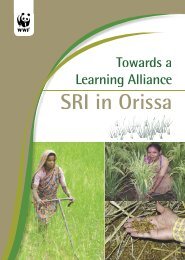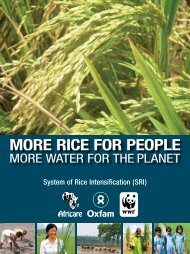SSI Newsletter - SRI - India
SSI Newsletter - SRI - India
SSI Newsletter - SRI - India
You also want an ePaper? Increase the reach of your titles
YUMPU automatically turns print PDFs into web optimized ePapers that Google loves.
SugarCane<br />
matters<br />
Tamil Nadu<br />
Tamil Nadu stands first in sugarcane<br />
productivity in <strong>India</strong> at 105 t/ha<br />
(2007). The state is known for its well<br />
organized cooperative and private<br />
sugar mills. Eight farmers (two<br />
supported by Ponni Sugars, Erode<br />
and six from <strong>SRI</strong> Farmers’ Association,<br />
Thumbal, Salem district) attended a<br />
2-day training programme on <strong>SSI</strong> in<br />
the month of May 2009.<br />
Progress so far<br />
• Nursery materials to cover an area<br />
of 10 acres were provided to the<br />
Salem farmers on their request.<br />
• Planting was initiated in an area<br />
of 1.5 acres in the fields of Mr.<br />
Baskaran and Mr. Vinod during<br />
June-July 2009.<br />
• Though 25% mortality rate was<br />
observed in the nursery due to<br />
their selection of 11-month old<br />
canes, there were no such issues<br />
in the main field.<br />
• Presently, crops look healthy with<br />
an average of 18 tillers per clump.<br />
• On 22 nd June 2009, an awareness<br />
programme on <strong>SSI</strong> was organized at<br />
Thumbal with the support of the <strong>SRI</strong><br />
Farmers’ Association, sponsored by<br />
NABARD.<br />
• Needed support was assured<br />
from AGM, NABARD for the <strong>SSI</strong><br />
trainings in the state.<br />
Conclusion<br />
It is quite encouraging to note the<br />
wide adoption of <strong>SSI</strong> methods by<br />
farmers, millers and government<br />
agencies alike. The fact that almost<br />
all the farmers who underwent the<br />
training in <strong>SSI</strong> methods adopted the<br />
practices shows that the sugarcane<br />
farming community has received the<br />
<strong>SSI</strong> methodology well. The ongoing<br />
performance of the crop is quite<br />
promising in almost all the fields,<br />
compared to the crops being cultivated<br />
in the conventional methods.<br />
Farmers and field staff are confident<br />
that the present signs are indicators<br />
of a good harvest. More data<br />
and information with regard to<br />
improvement in yields and savings<br />
in inputs will be shared in this<br />
newsletter in the coming months.<br />
With the support from farmers, mills,<br />
NGOs and government agencies<br />
like NABARD, <strong>SSI</strong> would definitely<br />
have a significant role to play in<br />
the sugarcane sector of <strong>India</strong> in the<br />
future.<br />
Dr. N. Loganandhan is the Visiting Scientist<br />
at ICRISAT-WWF Project<br />
14<br />
Nov ‘09<br />
Sweet Revolution...<br />
(Contd. from page 9)<br />
(5) Avoid flooding. Do alternate furrow<br />
irrigation to minimize water loss,<br />
or employ a drip irrigation system.<br />
Drip irrigation is where you get<br />
80% savings on water.<br />
(6) Go organic. Gradually switch from<br />
inorganic to organic manures and<br />
bio-fertilizers. These are natural<br />
materials and do not pose any<br />
danger to the crop or soil. Organic<br />
methods help directly reduce the<br />
carbon footprint of sugarcane<br />
farming by reducing use of farm<br />
chemicals that require fossil fuels<br />
that emit carbon dioxide in their<br />
production. Organic methods also<br />
help build soil, not only add to its<br />
fertility.<br />
(7) Do bio-control of pests. Instead of<br />
applying pesticides, learn to apply<br />
biological methods of minimizing<br />
pest damage to your crop. An<br />
example of beneficial insects?<br />
Lady bugs are predators of aphids,<br />
mites, scale insects (Erv Evans,<br />
NC State U, ces.ncsu.edu), and<br />
caterpillars (Washington State U,<br />
spokane-county.wsu.edu).<br />
(8) Intercrop. You can intercrop<br />
wheat, potato, cowpea, French<br />
bean, chickpea, watermelon and<br />
many other crops with sugarcane<br />
with your wider spacing between<br />
rows and hills. Aside from the<br />
extra income, the intercrops will<br />
help control weed growth because<br />
of the combined denser canopy of<br />
the crops, depriving the weeds of<br />
sunlight.<br />
(9) Ratoon. Harvest the plant crop<br />
when weather conditions are<br />
conducive for stubble growth.<br />
Cut the canes close to the ground<br />
level.<br />
So: Neo-agriculture is not only saving<br />
on water but also saving on fertilizer,<br />
saving on seed, saving on cost,<br />
saving on time – and saving against<br />
pollution of the soil, water and air.<br />
This is a paradigm shift in thinking<br />
agriculture. I can imagine that neoagriculture<br />
is also good for other<br />
high-value crops like hybrid rice,<br />
fancy rice, tropical fruits, vegetables,<br />
flowers whatever. This is a change in<br />
climate in understanding agriculture.<br />
Biksham Gujja imagines <strong>SSI</strong> will<br />
replace farmer’s practice in 5 years<br />
in <strong>India</strong>. Beyond <strong>SSI</strong>, I am already<br />
imagining Sweet Revolution! 2009.<br />
Frank A.Hilario is a popular Filipino writer<br />
who is known for his extensive writings on<br />
issues of agriculture and other<br />
world concerns
















